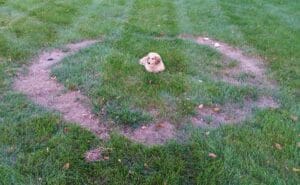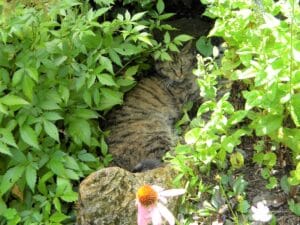Hello fellow readers, After our volunteer sing at the Karen Ann Quinlan Home for Hospice last Friday, my singing buddy, Ken of Branchville NJ, asked about grub remedies for his lawn riddled with brown patches. He tried a product from a home store, but it didn’t help. It may not be a grub dilemma, after all. Perhaps chinch bugs or a fungus amongst us is the culprit of Ken’s brown patchy lawn dilemma.
 How to identify if Chinch Bugs
How to identify if Chinch Bugs
I shared a trick that my turf professor suggested long ago. Push in a coffee can with both ends opened at least two inches deep into the soil on the edge of the area affected. Then fill the can with water. Wait about ten minutes and see if critters float to the top. Look closely as the as chinch bugs nymphs are tiny, the adults are about a quarter-inch long. They suck the sap out of the turf, causing dead patches that look like the impact of drought. It can be readily remedied organically by dusting the affected areas with a Diatomaceous Earth (DE) and Pyrethrin combo, such as Perma-Guard. The lawn will recover but give it time.
How to Check for Grubs
If no critters float, then remove a foot by foot piece of turf to check for grubs. It will be easy to peel back if you have a grub dilemma. But only if you see ten or more, is it considered a problem. A few root-feeding grubs will not impact a healthy lawn.
What are grubs anyway, you ask? They are the larvae of several kinds of beetles, the most known as a nemesis are Japanese beetles. I read about chemicals used to treat grubs, which makes my eyes glaze over. Never mind the risk of the substances drifting into your garden beds, and the impact on our environment and beneficial bugs.
Milky Spore is a safe, all-natural biological control using milky disease spores, which is lethal to Japanese beetle grubs but harmless to humans, pets, and beneficial insects. The bacteria will live in the soil for 10 to 15 years and can be applied anytime the ground is not frozen.
A brown patchy lawn could be a fungus
If not grubs and chinch bugs, perhaps Ken’s dilemma is a fungus which recalls a column about fairy rings. They appear as dark green or brown circular bands ranging in size from a few inches to fifty feet. Mushrooms can then develop in a circle outside of the rings during spring and fall after periods of heavy rain.
Ken sent a picture of his blotchy brown lawn—a mottled pattern rather than rings which could be dollar spot. Have you ever noticed shiny clusters of droplets on what looks like cobwebs in the yard? The webs are the branching nature of dollar spot fungus, which ultimately causes silver dollar sized brown spots in the lawn. Spots can spread into much larger irregular shapes and grow together, making large patches of brown areas in your yard.
Prevention is the best strategy
Prevention is the best remedy to fungus by removing excess thatch and aerating compacted soils, and watering lawns in the early morning during periods of drought. Topdressing your yard with aged manure or finished compost to encourage beneficial soil microbes will also help prevent disease.
Keep your lawn three inches high to ensure a robust root structure. While turf damage can be more severe if nitrogen is deficient, always test your soil before fertilizing and never over-fertilize as it can increase other turf diseases. A healthy lawn will endure fungus and insects, consider them a part of the cycle of life.
Garden Dilemmas? AskMaryStone@gmail.com (and now on your favorite Podcast App.)
You’ll enjoy the antics of Curt’s brother in a previous column about Fairy Rings
While prevention is best, there are suggested earth-friendly ways to control or treat Dollar Spot and Fairy Rings offered by Planet Natural.





